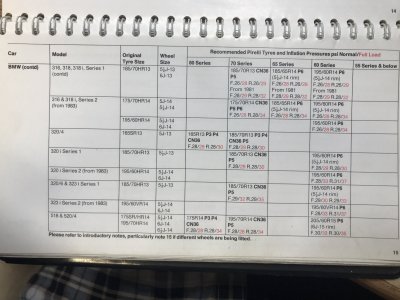Dougal Cawley
Active Member
When you are working out the set up of a car it is a balance between handling and straightline braking. I think what road and track were saying is fatter tyres would have improved straight line braking - full stop!. however BMW were considering the derogatory effects on handling when fitting wider tyres. It is easy for a journalist to critisize what is there, but they don't have to consider how to fix that element, and the effects that fix might have on other features that BMW were trying to balance.
low profile tyres were all the rage in that period of the 1970s. Pirelli had just done 60 profile tyres on Porsche, and Porsche and Ferrari had just done fitting bigger tyres on the rear of a road cars. Then in 1974 all the megga low profile tyres such as the P7 and the TRX started to come out. Some of the bigger sports cars were going down the same route the luxury saloon cars so, ferrari started to fit 215/70R15 Michelin XWX, while Maserati and Lamborghini were fitting 215/70VR15 Cinturato CN12, the big Mercedes were 205/70VR14 and 215/70R14 for a special treat on the 6.3 cars. I can only think of the Silver Shadow and Aston Martin V8 that fitted anything bigger on the front, with 225/70VR15 Cinturato CN12 on the DBS V8 and 235/70VR15 Avon TurboSpeed on the Shadow. But lets face it that Silver Shadow wasn't know for its handling, but it certain ly could stop very impressively in a straight line (considering its weight).
So i think waht is interestig is what did BMW do with their cars. So i think BMW's continuation of the E3 was onto the & series, which continued to fit 195/70R14, but then 205/70VR14 on the top range models, and then i beleive they also offered 220/55R390 TRX, and the E9 turned into the 6 Series, which offered the same tyre choice. it woudl be interesting to know what changes BMW did at this point, stiffere anti roll bars, different camber and caster settings, stiffer springs, less travel in the suspension etc.
then it seems to me that in about 1986 (according to my books) the more sporting of these models when for taller rims and wider low profile tyres with 240/45R415 TRX. what adjustments did BMW make at that period? what were the press reports at the time. the Buzz was about low profile.
It is however interesting to note that at the same time the smaller sports cars known for their best handling Alfa, Lotus Elan were fitting 165R14 or 165R13, oh and guess what tyre the 2002 was fitting? yep well done; it is 165R13. I think it was only when Alpina pretty much turned it into a full blown racing car that it got fitted with the 185/70VR13 Pirelli Cinturato CN36 that it fitted wider tyres, but you can bet your underpants they had done a selection of other modifications to make them work well as a track car.
Incidentally Michelin do still make the TRX
 www.longstonetyres.co.uk
www.longstonetyres.co.uk
And they are great tyres.
low profile tyres were all the rage in that period of the 1970s. Pirelli had just done 60 profile tyres on Porsche, and Porsche and Ferrari had just done fitting bigger tyres on the rear of a road cars. Then in 1974 all the megga low profile tyres such as the P7 and the TRX started to come out. Some of the bigger sports cars were going down the same route the luxury saloon cars so, ferrari started to fit 215/70R15 Michelin XWX, while Maserati and Lamborghini were fitting 215/70VR15 Cinturato CN12, the big Mercedes were 205/70VR14 and 215/70R14 for a special treat on the 6.3 cars. I can only think of the Silver Shadow and Aston Martin V8 that fitted anything bigger on the front, with 225/70VR15 Cinturato CN12 on the DBS V8 and 235/70VR15 Avon TurboSpeed on the Shadow. But lets face it that Silver Shadow wasn't know for its handling, but it certain ly could stop very impressively in a straight line (considering its weight).
So i think waht is interestig is what did BMW do with their cars. So i think BMW's continuation of the E3 was onto the & series, which continued to fit 195/70R14, but then 205/70VR14 on the top range models, and then i beleive they also offered 220/55R390 TRX, and the E9 turned into the 6 Series, which offered the same tyre choice. it woudl be interesting to know what changes BMW did at this point, stiffere anti roll bars, different camber and caster settings, stiffer springs, less travel in the suspension etc.
then it seems to me that in about 1986 (according to my books) the more sporting of these models when for taller rims and wider low profile tyres with 240/45R415 TRX. what adjustments did BMW make at that period? what were the press reports at the time. the Buzz was about low profile.
It is however interesting to note that at the same time the smaller sports cars known for their best handling Alfa, Lotus Elan were fitting 165R14 or 165R13, oh and guess what tyre the 2002 was fitting? yep well done; it is 165R13. I think it was only when Alpina pretty much turned it into a full blown racing car that it got fitted with the 185/70VR13 Pirelli Cinturato CN36 that it fitted wider tyres, but you can bet your underpants they had done a selection of other modifications to make them work well as a track car.
Incidentally Michelin do still make the TRX
Michelin TRX Tyres - Classic Michelin Tyres
Michelin TRX tyres - Tel: +44 1302714072 The classic range of Michelin TRX tyres, perfect for youngtimer classic cars. Michelin TRX tyres online.
And they are great tyres.

